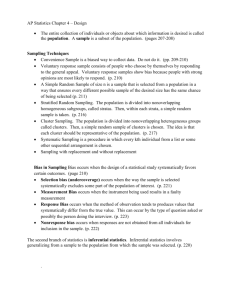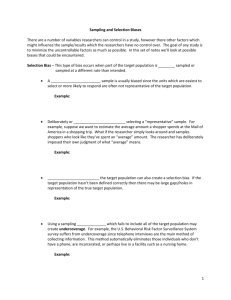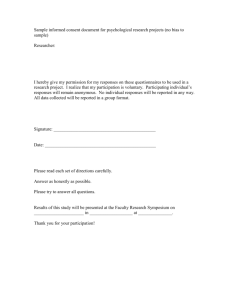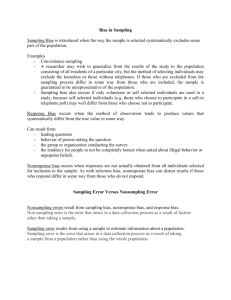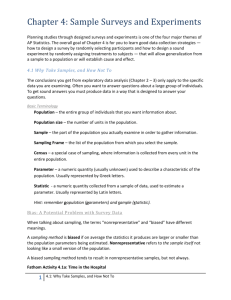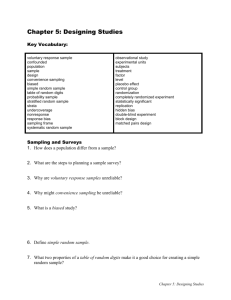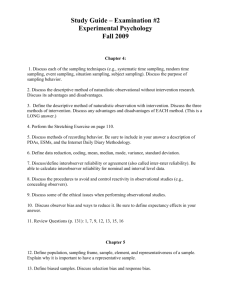Surveys - University of Adelaide
advertisement
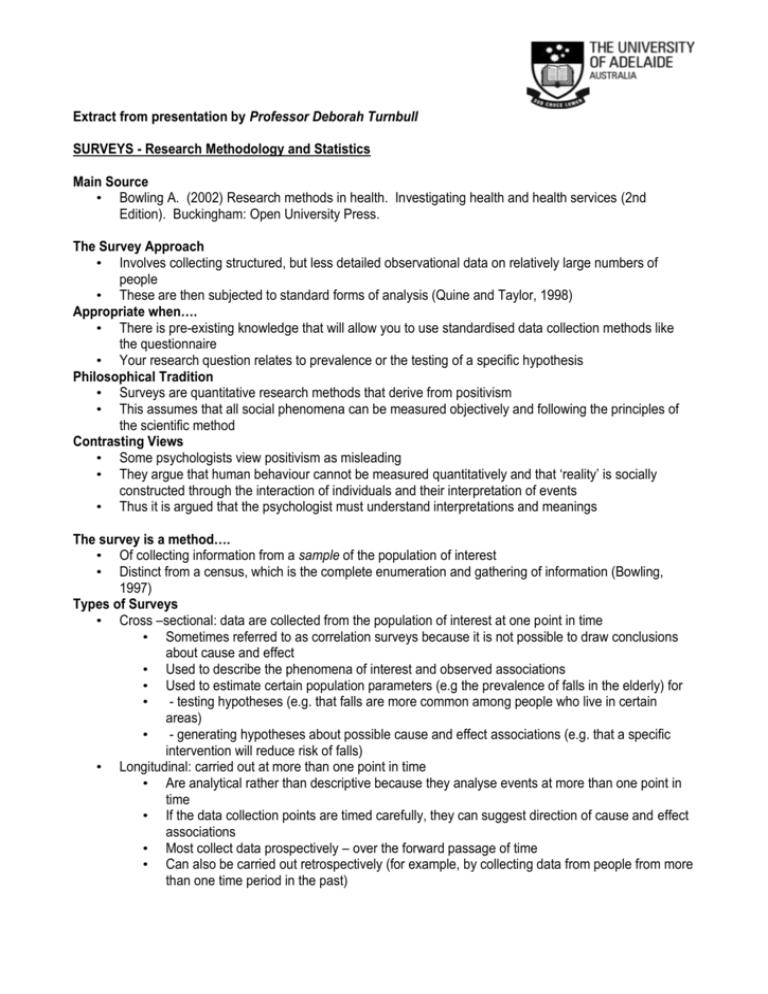
Extract from presentation by Professor Deborah Turnbull SURVEYS - Research Methodology and Statistics Main Source • Bowling A. (2002) Research methods in health. Investigating health and health services (2nd Edition). Buckingham: Open University Press. The Survey Approach • Involves collecting structured, but less detailed observational data on relatively large numbers of people • These are then subjected to standard forms of analysis (Quine and Taylor, 1998) Appropriate when…. • There is pre-existing knowledge that will allow you to use standardised data collection methods like the questionnaire • Your research question relates to prevalence or the testing of a specific hypothesis Philosophical Tradition • Surveys are quantitative research methods that derive from positivism • This assumes that all social phenomena can be measured objectively and following the principles of the scientific method Contrasting Views • Some psychologists view positivism as misleading • They argue that human behaviour cannot be measured quantitatively and that ‘reality’ is socially constructed through the interaction of individuals and their interpretation of events • Thus it is argued that the psychologist must understand interpretations and meanings The survey is a method…. • Of collecting information from a sample of the population of interest • Distinct from a census, which is the complete enumeration and gathering of information (Bowling, 1997) Types of Surveys • Cross –sectional: data are collected from the population of interest at one point in time • Sometimes referred to as correlation surveys because it is not possible to draw conclusions about cause and effect • Used to describe the phenomena of interest and observed associations • Used to estimate certain population parameters (e.g the prevalence of falls in the elderly) for • - testing hypotheses (e.g. that falls are more common among people who live in certain areas) • - generating hypotheses about possible cause and effect associations (e.g. that a specific intervention will reduce risk of falls) • Longitudinal: carried out at more than one point in time • Are analytical rather than descriptive because they analyse events at more than one point in time • If the data collection points are timed carefully, they can suggest direction of cause and effect associations • Most collect data prospectively – over the forward passage of time • Can also be carried out retrospectively (for example, by collecting data from people from more than one time period in the past) A Critical Consideration – Validity • The extent to which what you as a researcher claims is going on, actually is the case • A study is valid if its results correspond to the truth (Beaglehole et al, 1993) • For a study to be useful it must be internally valid • The results are correct for the particular group being studied Producing a valid survey • First - there should be no systematic error (or bias) • Main sources of systematic error - selection bias and measurement bias • Selection bias - when those selected for a study are different to those who are not selected Response Rates • Calculated out of the number of eligible respondents successfully included in the study • Percentage of the total eligible population • No agreed standard, although it is appears to be generally accepted that a response rate of 75% and above is good • Response rates can be higher for interview than for postal and telephone surveys Methods for increasing response • The covering letter • Advance letters • Incentives • Translations and interpreters • Appearance of the interviewer • Call backs, recalling and postal reminders Item non-response • The most common method is to assign the missing item the average value of the completed items • Most statistical packages have a procedure that will allow this • See: Kalton G (1983) Compensating for missing survey data. Ann Arbour: Institute for Social Research, University of Michigan Measurement Bias • When your individual measurements of variables of interest are inaccurate (ie they do not measure correctly to what they are supposed to do so) • Some Examples • Acquiescence (‘yes saying’) response set • Recall bias • Response style bias • Social desirability bias Something Else to Consider • Reactive effects - the process of testing may change the phenomena being studied • How to control for these - study design; study process - blinding and instructions to participants Random Error • Random error should be as small as possible • The divergence, due to chance alone, of an observation on a sample from the true population value (Beaglehole et al 1993) • One-off type mistakes in the way you select people or take measurements from them External Validity • The extent to which the results can be applied elsewhere • Assisted by clearly-stated hypotheses in well-defined samples • Even a survey that is perfectly valid internally may be of no consequence because the results cannot be compared with other studies (Beaglehole et al., 1993) Sampling • Has important implications for external validity • Best way to ensure you obtain a generalisable sample is via random sampling So what exactly is a sample? • Smaller number of people drawn from a population • Advantages of sampling over complete population coverage - financial and better quality data • Random Sampling • Each member of the target population group has an equal or known chance of being selected for your study • Can be achieved by: drawing names from a hat, computer programs, random number tables • Simple random sampling - for when you have a list arranged in a random order • Systematic random sampling - for when you have an organized list • Stratified random sampling - for guarding against leaving out or over sampling from certain groups • Cluster and multi-stage sampling - for when you don’t have a list from which to sample Data Collection Methods • Some studies rely on data from records (e.g. medical records) • Self-administered questionnaires and interview methods are probably the most common means of data collection Questionnaires/ Interviews • Can be structured or semi-structured • Another approach – unstructured schedules (exploratory, in-depth, free-style) Structured Approaches • Involves the use of fixed (standardised), questions, batteries of questions, psychological tests, scales • Presented to respondents in the same way with no variation in question wording and with mainly precoded response choices • Used in face - to - face , postal and telephone surveys Advantages • Able to collect unambiguous and easy to count answers, leading to quantitative data for analysis • Relatively economical and large samples of people can be included Disadvantages • Pre-coded response choices may not be sufficiently comprehensive and not all answers may be easily accommodated • Good for collecting factual data but can be subject to error in relation to the collection of information about attitudes, behaviour and social processes • Always scope for measurement bias Semi-structured Approaches • Includes mainly fixed questions but with no, or few response codes • Are used flexibly by the researcher to probe and to enable respondents to raise other relevant issues not originally covered Postal questionnaires and self-administration • The self-administered or postal questionnaire is less of a social encounter than interview methods • These questionnaires can be posted to people to minimise social desirability and interviewer bias Structured and semi-structured interviews • Face-to-face interviews - can probe fully - no literacy requirements - can be expensive and time consuming • Telephone interviews Further reading • For sample size calculation see: G Williams. What sample size do I need? Aust NZ J Public Health, 1999, 23(2), 215-7 • For questionnaire development see: J Cockburn, T De Luise. Some issues regarding reliability and validity. Health Promotion Journal of Australia, 1992, 2(2): 49-54


